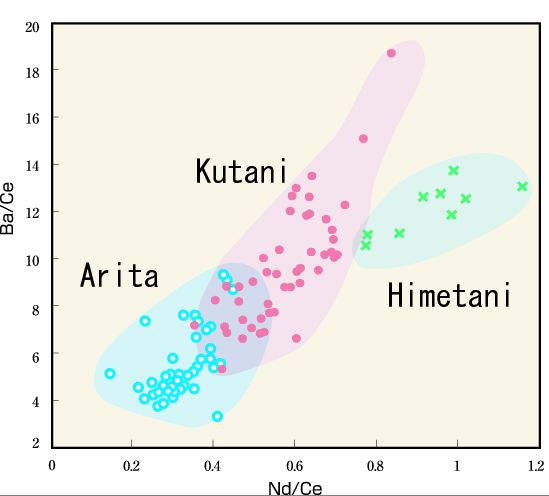陶磁器の微量分析測定
問い合わせ番号
SOL-0000001305
ビームライン
BL08W(高エネルギー非弾性散乱)
学術利用キーワード
| A. 試料 | 無機材料, 有機材料 |
|---|---|
| B. 試料詳細 | 環境関連物質 |
| C. 手法 | 蛍光X線 |
| D. 手法の詳細 | 微量元素分析 |
| E. 付加的測定条件 | 室温 |
| F. エネルギー領域 | X線(>40 keV) |
| G. 目的・欲しい情報 | 元素分析(微量) |
産業利用キーワード
| 階層1 | 環境 |
|---|---|
| 階層2 | 環境物質 |
| 階層3 | 焼却灰 |
| 階層4 | 元素分布 |
| 階層5 |
分類
A60.20 環境物質, A80.30 無機材料, A80.32 有機材料, A80.40 環境材料
利用事例本文
蛍光X線分析は物質に含まれる元素組成を調べることのできる簡便な手法です。この手法は、非破壊であり、また、100keVを超える高エネルギーX線を使用することで、希土類などの重元素の組成分析に敏感です。
図に示すのは、陶磁器について測定した希土類の組成比です。この結果から、産地によりその組成比に特徴があることがわかりました。
有田、九谷、姫谷産の陶磁器の測定結果。蛍光X線測定による各希土類のピーク強度比の分布図
画像ファイルの出典
所内報
誌名
Spring-8 News, 6 (2001)
ページ
測定手法
試料に高エネルギーX線を入射し、散乱角90度に設置したGe-半導体検出器で蛍光X線をエネルギー分光します。
画像ファイルの出典
図なし
測定準備に必要なおおよその時間
4 時間
測定装置
| 装置名 | 目的 | 性能 |
|---|---|---|
| 高エネルギー蛍光X線スペクトロメーター | 蛍光X線分析 |
参考文献
| 文献名 |
|---|
| Spring-8 News, 6 (2001) |
関連する手法
アンケート
ユーザー持ち込み装置を使った
測定の難易度
初心者でもOK
データ解析の難易度
初心者でもOK
図に示した全てのデータを取るのにかかったシフト数
4~9シフト

